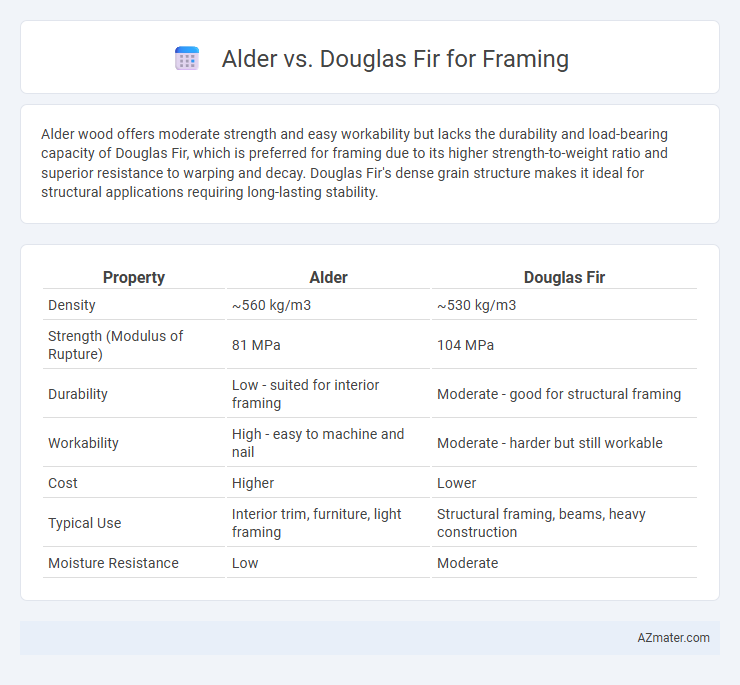Alder wood offers moderate strength and easy workability but lacks the durability and load-bearing capacity of Douglas Fir, which is preferred for framing due to its higher strength-to-weight ratio and superior resistance to warping and decay. Douglas Fir's dense grain structure makes it ideal for structural applications requiring long-lasting stability.
Table of Comparison
| Property | Alder | Douglas Fir |
|---|---|---|
| Density | ~560 kg/m3 | ~530 kg/m3 |
| Strength (Modulus of Rupture) | 81 MPa | 104 MPa |
| Durability | Low - suited for interior framing | Moderate - good for structural framing |
| Workability | High - easy to machine and nail | Moderate - harder but still workable |
| Cost | Higher | Lower |
| Typical Use | Interior trim, furniture, light framing | Structural framing, beams, heavy construction |
| Moisture Resistance | Low | Moderate |
Introduction to Alder and Douglas Fir
Alder is a hardwood known for its moderate strength, fine grain, and ease of workability, often used in furniture and cabinetry but less common in structural framing. Douglas Fir, a softwood, is highly valued in the construction industry for its exceptional strength-to-weight ratio, durability, and resistance to decay, making it a top choice for framing and heavy structural applications. Understanding the basic properties of Alders and Douglas Fir helps determine their suitability in framing projects, with Douglas Fir typically preferred for load-bearing structures.
Wood Characteristics: Alder vs Douglas Fir
Alder wood features a fine, straight grain with a smooth texture, making it easy to work with and ideal for interior framing where aesthetics matter. Douglas Fir boasts exceptional strength, stiffness, and durability due to its dense grain and resin content, making it a preferred choice for structural framing in construction. The natural resistance to decay in Douglas Fir surpasses Alder, enhancing longevity in load-bearing applications exposed to moisture.
Strength and Structural Performance
Douglas Fir exhibits superior strength and structural performance compared to Alder, making it a preferred choice for framing in construction. With a higher modulus of elasticity and greater bending strength, Douglas Fir supports heavier loads and provides better resistance to warping and twisting. Alder, while easier to work with and more affordable, lacks the durability and load-bearing capacity necessary for critical structural applications.
Workability and Ease of Use
Alder wood offers excellent workability with its smooth grain and soft texture, making it easier to cut, shape, and fasten during framing projects. Douglas Fir is renowned for its strength and stiffness, but its harder, denser fibers require more effort to saw and nail, impacting ease of use. For framing applications where speed and simplicity in handling are essential, Alder provides a more user-friendly experience compared to the robust but more challenging Douglas Fir.
Durability and Resistance to Decay
Douglas Fir offers superior durability and decay resistance compared to Alder, making it a preferred choice for framing in structural applications. Its dense grain and natural oils provide enhanced protection against moisture and insect damage, ensuring longer-lasting performance in challenging environments. Alder, while easier to work with and more affordable, lacks the same level of toughness and resistance, which limits its use primarily to interior or non-load-bearing framing.
Cost Comparison: Alder vs Douglas Fir
Douglas Fir is generally more cost-effective than Alder for framing, offering a balance of strength and affordability ideal for structural applications. Alder tends to be pricier due to its hardwood characteristics and aesthetic appeal, making it less common for budget-conscious framing projects. When evaluating cost per board foot, Douglas Fir provides greater value for large-scale framing compared to the higher price and less durability of Alder.
Environmental Impact and Sustainability
Alder and Douglas Fir both offer sustainable options for framing, with Douglas Fir often sourced from fast-growing, sustainably managed forests certified by organizations like FSC or SFI, making it a renewable choice with a lower carbon footprint. Alder typically grows in riparian zones and is less common, so its availability is more limited, but it can be sustainably harvested when managed responsibly, contributing to biodiversity in mixed hardwood forests. Douglas Fir's higher strength-to-weight ratio means less material may be needed for structural framing, enhancing resource efficiency and reducing waste during construction.
Availability and Sourcing
Douglas Fir is widely recognized for its abundant availability and consistent supply in the North American market, making it a preferred choice for framing due to its strength and reliability. Alder, while valued for its fine grain and workability, is less commonly sourced and often limited to regional suppliers, which can impact availability for large-scale construction projects. Builders prioritizing easy access and steady inventory levels typically favor Douglas Fir over Alder for framing applications.
Common Applications in Framing
Alder wood, prized for its smooth texture and moderate strength, is commonly used in interior framing where aesthetic finish and ease of machining are important, such as in non-load-bearing walls and decorative frameworks. Douglas Fir, known for its superior strength, stiffness, and resistance to decay, is the preferred choice for structural framing in residential and commercial construction, including beams, joists, and studs. Both woods offer versatility, but Douglas Fir's durability under heavy load conditions makes it the standard in framing applications requiring high structural integrity.
Which Wood is Best for Your Project?
Douglas Fir is often preferred for framing due to its superior strength, stiffness, and resistance to warping, making it ideal for load-bearing structures. Alder, while softer and less durable, offers aesthetic appeal with its fine grain, making it better suited for interior finishes rather than structural framing. Choosing the best wood depends on project requirements: prioritize Douglas Fir for structural integrity and Alder for decorative, non-load-bearing applications.

Infographic: Alder vs Douglas Fir for Framing
 azmater.com
azmater.com